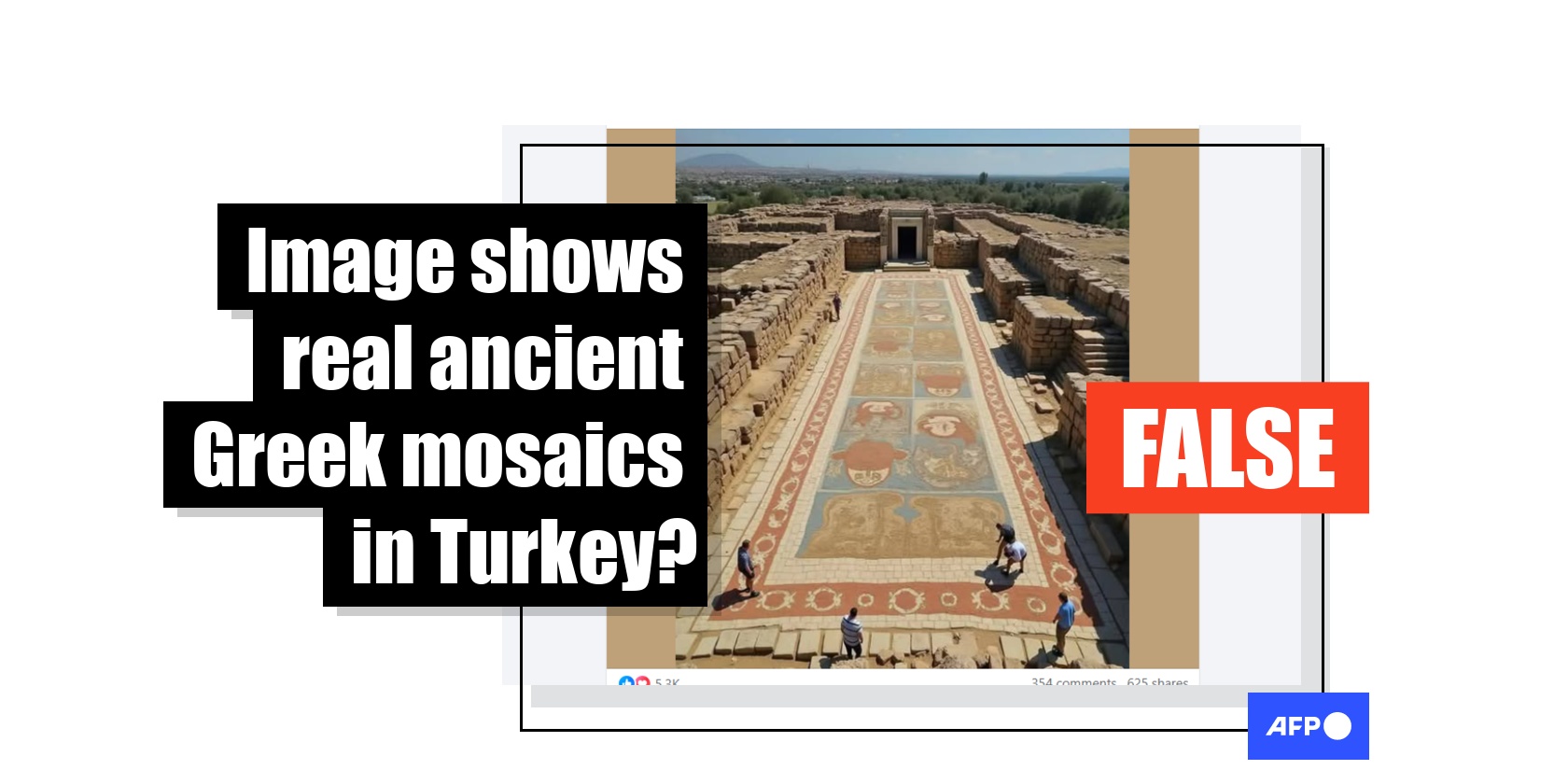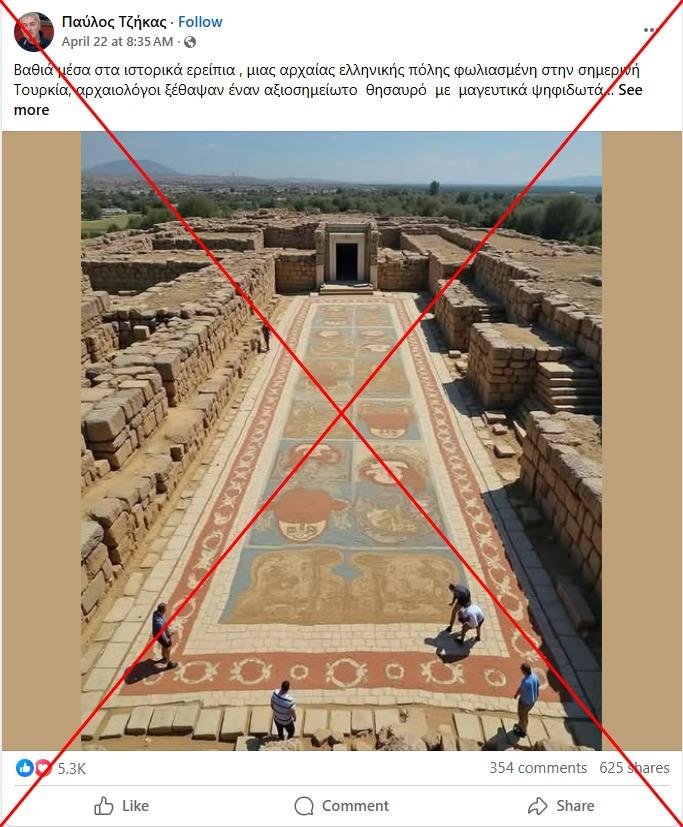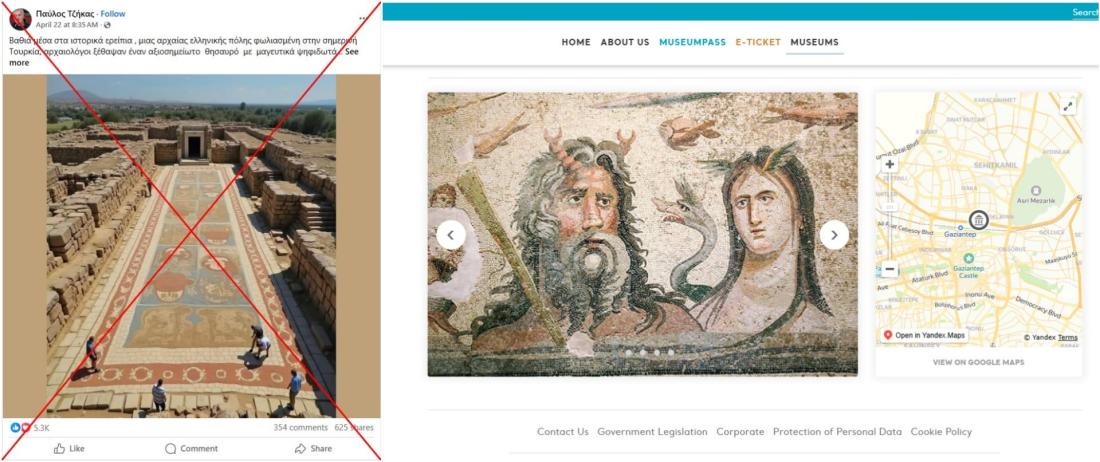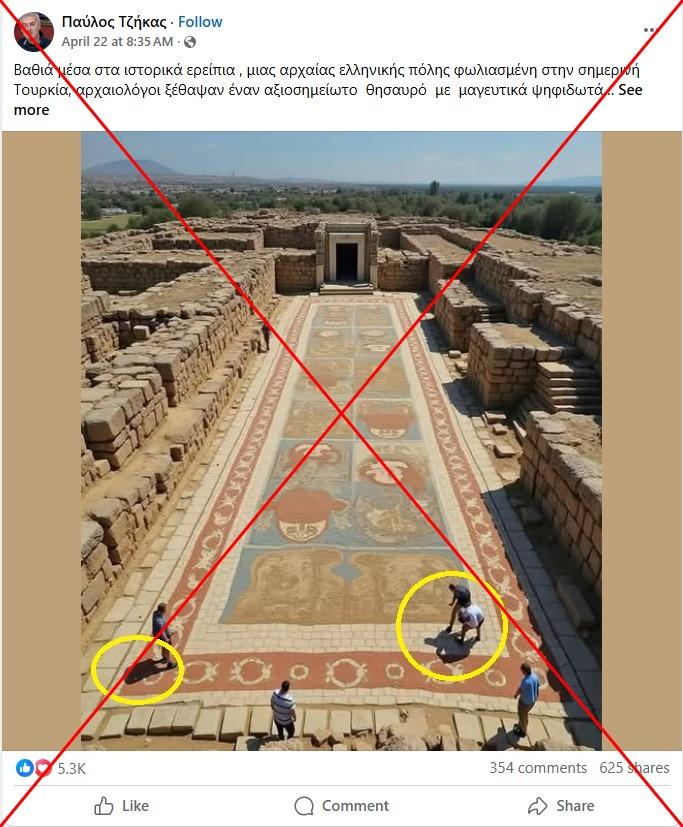
Fabricated image falsely claims to show ancient Greek mosaics discovered in modern Turkey
- Published on May 8, 2025 at 11:49
- 4 min read
- By Magdalini GKOGKOU, AFP Greece
"Deep within the historic ruins of an ancient Greek city nestled in what is now modern-day Turkey, archaeologists unearthed a remarkable treasure of enchanting mosaics over 2,200 years old," read this Facebook post published on April 22, 2025, since shared more than 630 times.
It included an aerial photo of floor mosaics surrounded by ancient ruins of walls against a backdrop of trees, portraying what appear to be mythological scenes.
The same photo and claim were also shared by other Facebook users (here, here and here).
Commenting on the posts, some users shared nationalistic and patriotic sentiments, claiming that "Hellenism" is "everywhere" and that "No matter what stone you lift, underneath you will find Greece!!!"
Misinformation glorifying ancient Greek civilisation is a common trope on social media and AFP has debunked many such misleading claims in the past.
The viral image does not show a real discovery of ancient Greek mosaics. Experts told AFP there were several elements in the image to suggest it lacks authenticity, including the colours and mosaic patterns, which are inconsistent with those typical of the 2nd or 3rd century BC.

Experts say mosaics are not real
A reverse image search traced the image to an English-language Facebook post with a similar misleading claim. A copyright symbol with the name "Ceausu Cristian" features in the bottom left-hand corner of the image.
A Facebook search for this username led to additional posts featuring historical or archaeological imagery, all featuring the same credit (examples here, here and here).
AFP found a Facebook account with the same username, including an archived version of it from 2020. He describes himself as a "digital creator" and is also an admin member of a history-focused Facebook group called "Art, History & Archeology from around the world". AFP sent him a direct message via Facebook on April 29, 2025 to inquire about the origin of the picture but did not receive a reply ahead of publication.
Experts told AFP that the mosaics in the photo were not genuine.
"As every archaeologist could tell you, this mosaic cannot be authentic," Catherine Abadie-Reynal, Emerita Professor of Greek Archaeology at the French Research Center HiSoMA, told AFP on May 5, 2025. She explained that there were several aspects in the image concerning the iconography, the colours and the global organization of the patterns, that are inconsistent with known mosaics of the 3rd or 2nd century BC, and "more generally, with known ancient mosaics".
"The general organisation in square panels is not possible for this period. This kind of organisation appears much later. It is used in the late Roman period," she said. During the 2nd and 3rd centuries BC, "mosaics present large and detailed scenes made out either of pebbles (with a very limited number of colours), or, at the end of the period, of very small fragments of stones (opus vermiculatum) showing many shades of colour. So, colours, with their large flat tints, are not plausible", she added.
She told AFP that the only visible patterns in the centre of the mosaic are very "odd" and resemble what she referred to as a "Teddy bear's head". Such patterns are "absolutely unknown on any ancient mosaic", she added. "The border, decorated with a kind of frieze of crowns is quite strange too and has nothing to do with the usual very rich and developed vegetal or geometric borders known on Hellenistic or Roman mosaics".
She also highlighted that between the centre of the mosaic and the border, there is an area apparently covered with white large rectangular paving stones, "a technical peculiarity that seems unique".
Similarly, Tuna Şare Ağtürk, Professor of Classical Art and Archaeology at the University of Oxford, agreed that "a quick look at the attached image makes it clear that this is a fake photograph". She briefly stated that "neither the scale nor the patterns and colours are consistent with what we would expect from mosaics of the 2nd or 3rd century BCE".
Another expert, Judith M. Barringer, Professor of Greek Art and Archaeology at the University of Edinburgh, told AFP on May 6, 2025, that "this certainly does not look authentic to me". "The borders, the main patterns, their form and placement all do not conform to what one would expect at this time".
The misleading English-language Facebook post claims that the ancient Greek mosaics shown in the photo were discovered "Deep within the terraced ruins of Zeugma", an ancient city in eastern Turkey known for its rich cultural heritage and archaeological significance. The Zeugma Mosaic Museum features a large collection of Roman and Late Antique mosaics and other artefacts.
Barringer explained it was unlikely that these mosaics were unearthed in Zeugma. She sent AFP examples of Zeugma mosaics in the Zeugma Mosaic Museum, highlighting that "such mosaics are largely figural, carefully structured compositions with clear borders and without blob-like forms".
She added that the colours in the shared image are "inconsistent with those of Zeugma" and that the "simplistic borders made of blocks, bear no resemblance to those of authentic mosaics".

Visual inconsistencies in the image
A closer look at the image shows that there are visual inconsistencies suggesting a high probability it was either fabricated or AI-generated. For example, several people pictured have odd-shaped shadows, and the person in the bottom right has an unusually long leg.
These image's inconsistencies are highlighted in the screenshot below:

AFP has previously debunked several AI-generated images in Greek and English.
Copyright © AFP 2017-2025. Any commercial use of this content requires a subscription. Click here to find out more.
Is there content that you would like AFP to fact-check? Get in touch.
Contact us
